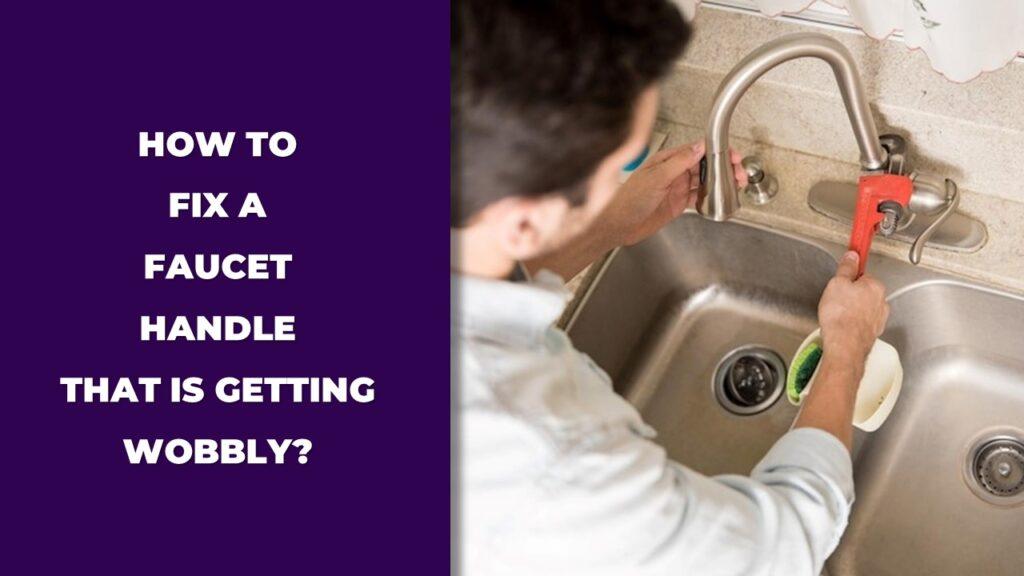
If your faucet handle’s getting wobbly, it probably just needs a simple fix, tightening the screw that holds it in place. Most handles have a small set screw or handle screw, usually hidden under a cap. When this loosens up, the handle starts to wiggle or even lift off the stem. Sometimes, though, the problem’s deeper—a loose nut under the sink or a worn-out cartridge inside the faucet. The good news is, you can fix this yourself with a screwdriver, an Allen wrench, or maybe a basin wrench. It’s one of those fixes that sounds harder than it is.
In this guide, we’ll walk through the reasons your faucet handle gets wobbly, how to spot the exact problem, step-by-step instructions for tightening it up, and what to do if that doesn’t work.
Why Is My Faucet Handle Getting Wobbly?
Here are the reasons why your faucet handle might feel loose:
- The set screw holding the handle is loose.
- The cartridge inside the faucet is worn or stripped.
- The retaining nut under the sink has loosened.
- The faucet wasn’t installed properly or was overtightened.
A wobbly faucet handle isn’t exactly rare. It happens—whether it’s from daily use, age, or a rushed install. The real question is why it’s loose. Sometimes it’s an easy fix, like a screw that just needs a quick turn. Other times, it’s a bigger problem, like a worn cartridge or a loose nut under the sink. Let’s break it down step by step so you can figure out what’s going on and get it fixed.
The Set Screw Has Loosened
Most faucet handles are held in place by a small set screw. Over time, these screws can loosen, especially with daily use—turning the faucet on and off, little by little, can shake things loose. When that happens, the handle feels wobbly or might even lift off the stem. The fix? Find the screw and tighten it back down. Usually, you’ll need an Allen wrench or a screwdriver, depending on the faucet. Tighten it snug, and the handle should feel solid again.
The Cartridge Is Worn or Stripped
If the handle’s still loose after tightening the screw, the problem might be inside. The faucet cartridge is what controls the water flow. It connects to the handle, so if it’s worn down or stripped, the handle won’t sit right and might spin or wobble. This can’t be fixed with a simple tightening, you’ll need to replace the faucet cartridge. Make sure to get the right size for your faucet. Bring the old one to the store if you’re not sure.
The Retaining Nut Underneath Is Loose
Sometimes, the whole faucet feels like it’s moving, not just the handle. If that’s the case, the nut that holds the faucet to the sink might be loose. You’ll have to crawl under the sink for this one. Look for the retaining nut and tighten it using a basin wrench or an adjustable wrench. This part can feel awkward to reach, but once it’s snug, the faucet should stay put.
Improper Installation or Excessive Force
Handles can get loose if the faucet wasn’t installed properly in the first place. Or maybe someone cranked down too hard on the handle, thinking they’d get an extra-tight seal, but ended up damaging threads or shifting parts. If that’s the case, you might have to replace the damaged part or reinstall the faucet the right way. It’s a bit more work, but it’s worth doing right so you don’t have to mess with it again anytime soon.
Tools and Materials You’ll Need
Here’s a quick list of the tools you might need to fix a wobbly faucet handle:
- Allen wrench (hex key)
- Flathead or Phillips screwdriver
- Adjustable wrench or basin wrench
- Pliers (in case parts are stuck)
- Flashlight (for seeing under the sink)
- Plumber’s tape (optional, helps things stay tight)
- Thread sealant (optional, for extra grip)
- Towel or bucket (for any drips or messes)
Before you start, grab your tools and take a look at your faucet. You might not need everything on the list, but having it all handy saves you from stopping halfway through. If you think you’ll need to swap out the cartridge, it’s a good idea to get a replacement that matches your faucet model. That way, you’re ready for whatever you find when you open it up.
Step-by-Step Guide: How to Fix a Wobbly Faucet Handle
Here’s the step-by-step guide to fixing a wobbly faucet handle:
- First, turn off the water.
- Find the set screw or handle screw.
- Grab the right tool and tighten it up.
- Test the handle, see if it’s steady.
Most of the time, a loose faucet handle is just a simple case of a screw that’s worked itself loose over time. It happens. You turn the handle day after day, and little by little, it starts to wiggle. Don’t stress—it’s usually an easy fix. I’ll walk you through it like I’m there next to you.
Step 1: Turn Off the Water Supply
Alright, first things first—turn off the water. You don’t want a surprise spray in the face, right? Look under your sink for the shut-off valves. They’re those little knobs connected to the pipes. Give them a twist clockwise. Then turn the faucet on just to let any water left in the line flow out. That way, you’re not dealing with drips while you work.
Step 2: Access the Set Screw or Handle Screw
Now, check the handle. Most faucet handles have a tiny set screw holding them in place. It’s usually hidden under a little cap on top of the handle. You can pop it off gently with a flathead screwdriver or even a butter knife. Look under the cap—see that screw? It might be a hex screw for an Allen wrench, or maybe a Phillips or flathead screw. Either way, that’s your culprit.
Step 3: Tighten the Screw
Once you see the screw, grab the right tool. An Allen wrench or a screwdriver will do the trick. Give the screw a firm turn clockwise. Not too tight—you’re not trying to break anything, just snug enough so the handle feels secure. If you’ve got plumber’s tape or thread sealant, you can add a little before tightening it down. It helps the screw stay put longer.
Step 4: Test the Handle
Alright, moment of truth. Turn the water back on and give the handle a try. Move it back and forth, twist it on and off. If it feels solid and doesn’t wiggle, you’re done. That’s all there is to it. If it’s still loose, don’t worry—we’ve got a couple more things to check.
If the Handle Is Still Wobbly: Check These Parts Next
Here’s what to check if the screw wasn’t the whole story:
- The nut under the sink might have come loose.
- The cartridge inside the faucet could be worn down.
Sometimes a loose handle is just the tip of the iceberg. If you’ve tightened the screw and it’s still wobbly, let’s take a peek at what else could be going on.
Check the Retaining Nut Under the Sink
If the whole faucet seems to move, not just the handle, there’s a good chance the retaining nut under the sink is loose. Time to crawl under there. Grab a flashlight if you need it, and look up at where the faucet connects to the sink. See that big nut? That’s the one. Use a basin wrench or an adjustable wrench to snug it up. A loose nut here can make the whole faucet shift when you use it, so it’s worth tightening.
Inspect the Cartridge for Wear
If you’ve done all that and the handle still feels sloppy, the problem might be deeper inside—the cartridge. The cartridge is what makes the water flow when you turn the handle. If it’s worn or stripped, the handle won’t sit right, no matter how tight the screw is. You’ll need to take the handle off again and check the cartridge. If it looks chewed up or damaged, it’s time to replace it. Bring it to the hardware store to make sure you get the right one. Swap it out, put everything back together, and give the handle a test. That should sort it out.
How to Prevent Faucet Handles from Getting Wobbly Again
Here’s how to keep your faucet handle from getting wobbly again:
- Check the handle screws every few months and tighten if needed.
- Don’t crank the handle too hard—just use normal pressure.
- Add thread sealant or plumber’s tape to screws for a longer-lasting hold.
The truth is, faucet handles loosen up over time. It’s just part of the deal when you use something every day. But you can help them stay tight longer if you give them a little attention now and then. Every few months, take a quick peek at the handle screws—just a quick turn of a wrench can stop a loose handle before it starts to wobble.
And here’s another thing: how you use the faucet matters too. If you’re slamming the handle down or twisting it too hard, that’s going to wear out the parts faster. A gentle hand goes a long way in keeping things in good shape.
Lastly, if you’ve had trouble with the screw loosening often, you can add a dab of thread sealant or wrap the threads with plumber’s tape before tightening. It’s a simple trick that helps keep the screw in place longer. Small step, big difference.
When to Call a Professional Plumber
Here’s when you should call a plumber for a wobbly faucet handle:
- If the handle is still loose after you’ve tightened the screw and nut.
- If the cartridge is worn, and you’re not sure how to replace it.
- If you see leaks, rust, or damage that’s beyond your DIY comfort zone.
Most of the time, fixing a loose faucet handle is something you can handle on your own. A screwdriver here, a wrench there—it’s a small fix. But if you’ve tightened everything you can, and the handle’s still wobbly, that’s a sign there might be a bigger problem hiding under the surface.
Leaking water, stripped threads, or a worn-out cartridge that just won’t budge—those are situations where it might be better to call in a plumber. There’s no shame in asking for help when the job’s too much for one person, especially if you don’t have the tools or the time.
And if your faucet is old or rusted, replacing parts might not cut it. Sometimes it’s smarter to replace the whole faucet, and a plumber can help you figure that out, too.
Quick Troubleshooting Table: Why Is My Faucet Handle Loose?
Here’s a quick breakdown of common faucet handle problems and how to fix them:
| Problem | Likely Cause | Solution |
| Handle wiggles, but still works | Loose set screw | Tighten set screw with correct tool |
| Handle spins or feels rough | Worn cartridge | Replace cartridge |
| The entire faucet moves | Loose retaining nut under sink | Tighten nut with basin wrench |
| The handle won’t tighten properly | Stripped threads or damaged parts | Replace parts or call a plumber |
When a faucet handle starts acting up, it’s usually one of these problems. Most of the time, it’s just a loose screw, but if you’re not sure, this table gives you a quick way to figure out what’s going on and what you need to do.
Conclusion
So, fixing a wobbly faucet handle? Honestly, it’s not that hard once you figure out where the problem is. Most times, it’s just a loose screw—grab the right tool, give it a twist, and you’re back in business.
But yeah, sometimes it’s not that simple. If the handle keeps getting loose no matter what you do, it might be the cartridge wearing out or a nut under the sink that’s come loose. That’s when you gotta get a bit more hands-on—crawl under the sink, check the parts, maybe swap out the cartridge.
And hey, if none of that works, or if you just don’t have the time (or patience), no shame in calling a plumber. Sometimes it’s worth paying someone else to deal with it, especially if you’re dealing with rusted parts or a faucet that’s past its prime.
Related FAQs
Can I fix a wobbly faucet handle without turning off the water?
No, it’s always safer to turn off the water supply before tightening or removing any faucet parts.
How do I know if my cartridge is worn out?
If the handle keeps spinning or feels loose even after tightening the screw, the cartridge is likely worn and needs replacing.
What size Allen wrench do I need for my faucet handle?
Most faucet handles use a 1/8-inch or 3/32-inch Allen wrench, but it’s a good idea to check your faucet’s manual or measure the screw.
Why does my handle keep loosening after I tighten it?
If the handle loosens again, the set screw might not be gripping properly, or the threads could be stripped. Using thread sealant or replacing worn parts can help.
Is it safe to use thread sealant or plumber’s tape?
Yes, using thread sealant or plumber’s tape is a smart way to keep the screw tight and prevent it from working loose over time.

Dylan Foster is a family man with years of hands-on experience in plumbing, household maintenance, and fixing everyday issues around the home. A former plumber, Dylan knows what it’s like to deal with tricky leaks, worn-out parts, and all the little problems that pop up in a house. From plumbing repairs to kitchen fixes and garden hose setups, he’s done it all. Dylan shares real-world solutions to help others keep their homes running smoothly and avoid costly mistakes.




